Summary
- A strategic and coherent approach for transformational changes in Civil Service is required for success. Individual initiatives, like rightsizing or salary adjustments, fall short of the goal.
- In general, public employees are committed and, in some cases, have been able to adapt to higher expectations and fewer resources, with practically no training to manage the changes.
- FOMB has dedicated resources to assessing the issue and has requested a more strategic “Civil Service Reform” as part of their 2021 Fiscal Plan.
- A Human Capital Framework for civil service transformation is the solution. It is driven by an overarching commitment to become “Citizen-Centric” and focuses efforts on five pillars: Capacity Planning, Talent Development, Performance Management, Compensation & Benefits, and Culture. Investments in Tangible and Intangible Infrastructure enable these pillars.
Overview
In recent history, government administrations have faced complex economic and social crises, in some cases aggravated by natural disasters, pandemics, migration, and government mismanagement. These challenges hinder their ability to provide an adequate public service to its citizens, which is their primary purpose. Governments have encountered austerity pressures resulting in limited personnel, outdated salary structures, increased workloads, and somewhat unmotivated staff. The government of Puerto Rico has not been the exception. The combination of crises faced over the last 20 years has turned the government into a seven-headed monster: exceptionally complicated to manage and unable to adapt to current circumstances. Most Puerto Ricans have lost faith in government leaders who have tried for years to tame the beast and facilitate the provision of services their constituents are expecting.
Multiple approaches have been proposed to manage the island’s civil service structure better. These include encouraging capacity planning and operational improvements, as well as workforce reductions, hiring freezes, reorganizations, and agency consolidations. When executed in silos, most of these proposals have demonstrated to be unsustainable in the long run, negatively impacting the service provided to citizens and ultimately deteriorating the work conditions and opportunities for public employees. Moreover, many initiatives have lacked a strategic approach, consequently underperforming expectations.
Civil servants have been consistently challenged with higher expectations, even when they have fewer resources and means to satisfy them. While supporting multiple public engagements, V2A Consulting (V2A) has come across hundreds of public employees that are strongly committed to making a positive difference in the lives of the citizens they serve. However, this call to serve or motivation is not enough. Agencies need the right people for the right tasks while providing adequate support systems to drive continuous service improvements and promote career development. Governments can only be effective if their employees are both motivated and able to implement policies and services effectively.
Considering the challenges mentioned above, the Financial Oversight and Management Board (FOMB) is now encouraging a comprehensive approach to develop a high-performance Puerto Rico government workforce to achieve continuous transformational change in civil service performance and service delivery outcomes[1]. The proposed Civil Service Reform considers a human capital framework that is currently under pilot in two agencies and is expected to boost the needed changes for the Puerto Rico government. This will serve as a guide for other agencies and allow adjustments to strengthen the framework. All human capital plans need to be based on priorities defined and set by the government and linked to the budgeting process for full compliance.
While the FOMB’s recommendations for a strategic approach are necessary, they may not be sufficient; many players still have skepticism regarding the government’s capacity to achieve the expected Civil Service Reform transformation. To regain trust and maximize chances of success, V2A recommends the development of a citizen-centric vision while providing the adequate tools and resources to execute it.
Public administrators must attract, recruit, retain, develop, compensate, and motivate high-performing employees even during times of budgetary constraint. It requires effective public sector leadership following a strategic transformation approach with human resource management that considers employees’ views and expectations. V2A’s proposed Human Capital Framework is structured around five strategic pillars integrated to support any organization’s vision and mission. To maximize the Civil Service Reform potential, an organization’s initiatives should be framed with this comprehensive approach and avoid the urge of executing them in silos.
[1] FOMB Policy Paper, Designing an Effective Civil Service Reform in Puerto Rico – Cultivating a High-Performing Public Workforce for a Government that Works, 2020
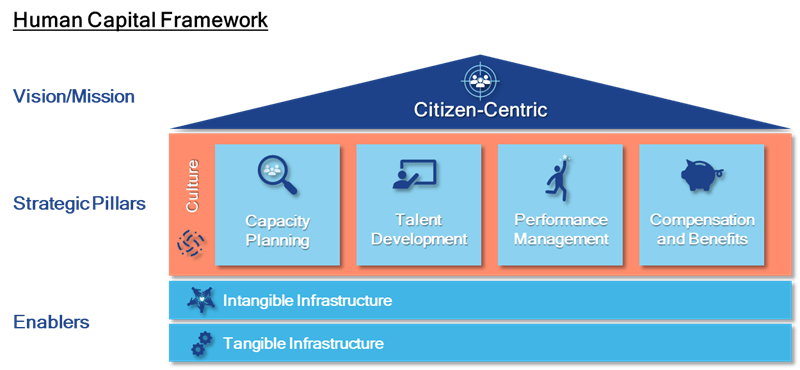
V2A’s Human Capital Framework
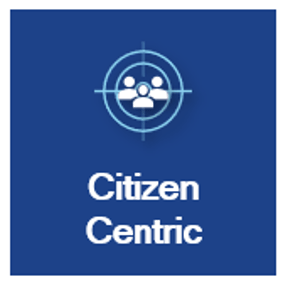 A Citizen-Centric focus should be the core of public agencies’ Human Resources (HR) strategy, similar to customer orientation for the private sector. HR must participate in strategic conversations and have a say in decision-making processes that impact the services rendered and, as a result, impact employees’ performance. Their role is to safeguard public employees’ conditions to focus on citizens. Some fundamental questions need to be addressed to ensure citizen centricity. Consider the following: How does a civil service of excellence look like from a citizen’s perspective? What is the government doing to satisfy that expectation?
A Citizen-Centric focus should be the core of public agencies’ Human Resources (HR) strategy, similar to customer orientation for the private sector. HR must participate in strategic conversations and have a say in decision-making processes that impact the services rendered and, as a result, impact employees’ performance. Their role is to safeguard public employees’ conditions to focus on citizens. Some fundamental questions need to be addressed to ensure citizen centricity. Consider the following: How does a civil service of excellence look like from a citizen’s perspective? What is the government doing to satisfy that expectation?
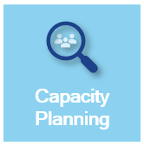 Capacity Planning is the process of developing ongoing resource management and decision-making given projected circumstances associated with personnel needs. The initial step for HR is to complete a capacity assessment to fully understand the capacity needed to fulfill the organization’s mission. It will give HR visibility to make better longstanding decisions on hiring, reallocation, and managing attrition. Moreover, it helps identify inefficient activities, labor-intensive or repetitive, which can be automated or digitalized, liberating personnel that could be reallocated in core areas with needs. Capacity management and planning is a continuous effort that allows HR to revisit resource management and ensure maximization of its workforce based on the organizations’ objectives.
Capacity Planning is the process of developing ongoing resource management and decision-making given projected circumstances associated with personnel needs. The initial step for HR is to complete a capacity assessment to fully understand the capacity needed to fulfill the organization’s mission. It will give HR visibility to make better longstanding decisions on hiring, reallocation, and managing attrition. Moreover, it helps identify inefficient activities, labor-intensive or repetitive, which can be automated or digitalized, liberating personnel that could be reallocated in core areas with needs. Capacity management and planning is a continuous effort that allows HR to revisit resource management and ensure maximization of its workforce based on the organizations’ objectives.
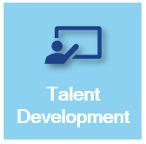 Talent Development is the result of “landing” the agency’s strategy regarding the capabilities required to attain its goals, with a strong focus on fostering citizen-centric and agency-critical skills, competencies, and attitudes. Agency leaders and HR managers must ask two fundamental questions: What skillset is required by our employees to accomplish a citizen-centric vision? And What is the current skillset of our workforce? The purpose is to understand the gap to determine how we need to train and develop our people.
Talent Development is the result of “landing” the agency’s strategy regarding the capabilities required to attain its goals, with a strong focus on fostering citizen-centric and agency-critical skills, competencies, and attitudes. Agency leaders and HR managers must ask two fundamental questions: What skillset is required by our employees to accomplish a citizen-centric vision? And What is the current skillset of our workforce? The purpose is to understand the gap to determine how we need to train and develop our people.
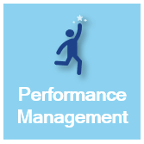 Performance Management is the process of identifying the expected performance levels to achieve the agency’s strategy, establishing goals for individual employees, and developing the workforce to meet those goals. Sustaining high performance requires a deliberate implementation of a system composed of the right roles necessary to achieve the vision, a set of expected competencies (for all employees and role-specific competencies as well), performance indicators, review recurrence (supervisors and their employees), goals to create the positive tension, competition, and incentives to motivate improvement.
Performance Management is the process of identifying the expected performance levels to achieve the agency’s strategy, establishing goals for individual employees, and developing the workforce to meet those goals. Sustaining high performance requires a deliberate implementation of a system composed of the right roles necessary to achieve the vision, a set of expected competencies (for all employees and role-specific competencies as well), performance indicators, review recurrence (supervisors and their employees), goals to create the positive tension, competition, and incentives to motivate improvement.
 The Compensation and Benefits pillar consists of identifying and implementing a fair and cost-effective way to reward employees. As mentioned earlier, the fiscal crisis has significantly impacted public employees’ compensation and benefits, increasing attrition and making recruiting even more complicated. The constant increase in the cost of living continues to put pressure on leaders to address compensation gaps; however, raising salaries will only be effective as part of an overarching effort to transform compensation strategy in general, which includes rewarding based on performance, harmonizing roles across agencies, and having visibility of employees’ skillsets and competencies across all departments. Beyond salaries, a creative approach at benefits can incorporate attractive perks like partnerships with local vendors for discounts or freebies, complimentary meals, uniforms, and others.
The Compensation and Benefits pillar consists of identifying and implementing a fair and cost-effective way to reward employees. As mentioned earlier, the fiscal crisis has significantly impacted public employees’ compensation and benefits, increasing attrition and making recruiting even more complicated. The constant increase in the cost of living continues to put pressure on leaders to address compensation gaps; however, raising salaries will only be effective as part of an overarching effort to transform compensation strategy in general, which includes rewarding based on performance, harmonizing roles across agencies, and having visibility of employees’ skillsets and competencies across all departments. Beyond salaries, a creative approach at benefits can incorporate attractive perks like partnerships with local vendors for discounts or freebies, complimentary meals, uniforms, and others.
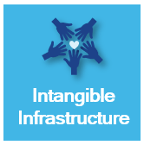 Intangible Infrastructure is all internal decisions and agreements that regulate how employees interact and how the agency operates. These include, among others: governance, policies, procedures, processes, organizational structures, stated values, codes of conduct, and competency models. A citizen-centric vision should deeply permeate the intangible infrastructure so that it privileges outcomes that favor the citizen. Critical questions could shed some light, for example: does the agency’s organizational structure allow to provide the expected level of service? Is the current public policy creating the conditions for a citizen-centric organization? Is the agency monitoring citizen satisfaction: establishing indicators, targets, and the governance to monitor them?
Intangible Infrastructure is all internal decisions and agreements that regulate how employees interact and how the agency operates. These include, among others: governance, policies, procedures, processes, organizational structures, stated values, codes of conduct, and competency models. A citizen-centric vision should deeply permeate the intangible infrastructure so that it privileges outcomes that favor the citizen. Critical questions could shed some light, for example: does the agency’s organizational structure allow to provide the expected level of service? Is the current public policy creating the conditions for a citizen-centric organization? Is the agency monitoring citizen satisfaction: establishing indicators, targets, and the governance to monitor them?
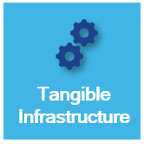 Tangible Infrastructure is all physical artifacts, including physical spaces, office equipment, IT hardware and software, machinery, communication systems, and all other assets that allow the agency to provide its services. Many agencies are doing the best they can with a legacy infrastructure that no longer supports a citizen-centric vision.
Tangible Infrastructure is all physical artifacts, including physical spaces, office equipment, IT hardware and software, machinery, communication systems, and all other assets that allow the agency to provide its services. Many agencies are doing the best they can with a legacy infrastructure that no longer supports a citizen-centric vision.
 Culture wraps and contains the rest of the strategic pillars and gives an organization its uniqueness based on its values and beliefs. Knowingly or unknowingly, culture affects how people interact and behave among themselves and with citizens. Having the pulse on the culture, understanding its best and worst attributes, and most importantly, understanding the size of the gap between the current and the desired culture allows agency leaders and HR directors to make impactful changes.
Culture wraps and contains the rest of the strategic pillars and gives an organization its uniqueness based on its values and beliefs. Knowingly or unknowingly, culture affects how people interact and behave among themselves and with citizens. Having the pulse on the culture, understanding its best and worst attributes, and most importantly, understanding the size of the gap between the current and the desired culture allows agency leaders and HR directors to make impactful changes.
Application of Holistic Approach
Common barriers for government leaders when trying to implement a significant initiative come from opposition or distrust from key stakeholders, inadequate human resources and systems, and lack of accountability, among others. Internal and external dependencies like competing priorities, conflict with other existing policies or laws, and the uncertainty brought by electoral cycles also contribute to derailing even the best efforts. As proposed in our Human Capital Framework, a comprehensive approach would plow through these barriers developing practical implementation plans that generate enduring results. Below is an illustrative example of a potential transformation using this approach.
One state agency is trying to comply with the rightsizing mandate. The first step taken included Capacity Planning, where they performed an in-depth assessment of each department’s workload and analyzed if the current employee workforce was able to complete the job required. Although results turned out to show that work can be done, when including a Citizen-Centric mindset, they noticed that the service level was not optimal. To ensure citizens’ expectations were met, they needed to: a) increase staff in their customer-facing departments and b) provide training to back-office employees to be more efficient processing orders. Therefore, as part of Talent Development efforts, a new People Development and Training program was created in the HR department, whose first goal was to transform employees’ skills in cloud collaboration to a more than proficient level. Also, employees in the agency’s call center were now allowed to work from home with their agency-provided laptop, which a) reduced absenteeism, b) improved performance, and c) lowered agency overhead costs while employees saved money on gas and business apparel. The agency’s Tangible Infrastructure began changing. Physical spaces dedicated to in-person employees were no longer needed and were available for other departments and sublet to other agencies to generate additional revenue. Policy changes and process improvements were revised along with other Intangible Infrastructure elements like collective bargaining agreements to facilitate the desired service level goal. A new Performance Management procedure was implemented where employees performing well were celebrated. Their achievements helped them apply for promotions within the agency or served as recommendation letters for opportunities in other agencies. As part of talent development efforts, each employee was provided a career path within the agency, and their Compensation and Benefits were defined by their professional development path. Although employees did not receive immediate salary adjustments, the agency negotiated with the local telecommunications provider and agreed to cover 50% of internet costs to their employees. Also, the agency organized a Citizen Centricity Committee, the “CCC,” where bi-weekly, key leaders and community stakeholders discussed performance indicators in their citizen-facing activities and internal service levels from supporting groups. In terms of Cultural transformation, the agency began to empower employees to go beyond their comfort zones and take risks to serve citizens better, as well as created an employee recognition program where each employee could recognize a colleague for going above and beyond what was expected. These actions enabled a collaborative and motivating work environment that attracted better talent for recruitment and improved retention safeguarding the agency’s knowledge continuity.
Conclusion
A civil service transformation of this magnitude requires the full engagement and buy-in of the workforce, agency directors, HR professionals, union leaders, and elected officials. Trust in our public employees’ talent and commitment can be rebuilt by following leaders’ vision and example, being transparent with the civil service reform’s objectives and progress, as well as understanding what public employees need to deliver quality public service. A strategic approach and precise methodology, ensuring alignment between the vision, public policy, legislation, and the mindsets and behaviors of all, ensure the sustainability of the reform even in the face of political changes in administration or its leaders.
V2A Consulting invites you to glimpse your organization’s strategic plan and reflect on how the citizen’s needs are currently served and how well equipped the employee is to delight that client. Are they the focus of the strategy? Will the plans under execution improve the work conditions of public employees? Will the public receive better service because of the projects in course? We encourage all leaders to look within and validate if the vision and mission of their organization are aligned with citizen and employee centricity. They should then focus on a plan and adjust the strategies to protect and enable that vision. It will be the key to long-lasting success not only for your organization but for the people you serve.
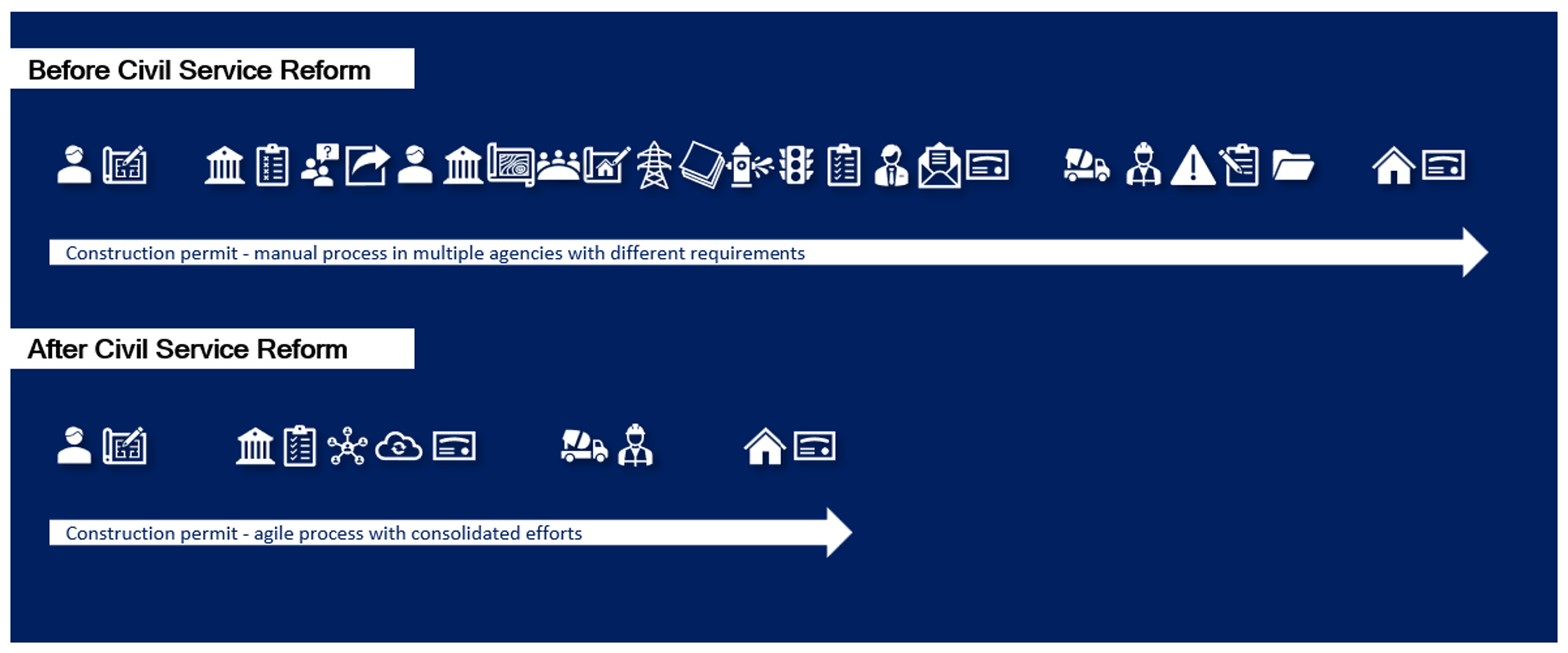
Disclaimer
Accuracy and Currency of Information: Information throughout this “Insight” is obtained from sources that we believe are reliable, but we do not warrant or guarantee the timeliness or accuracy of this information. While the information is considered to be true and correct at the date of publication, changes in circumstances after the time of publication may impact the accuracy of the information. The information may change without notice and V2A is not in any way liable for the accuracy of any information printed and stored, or in any way interpreted and used by a user.
